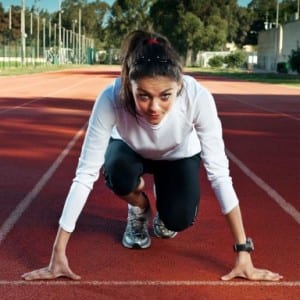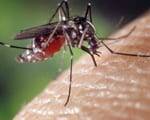Weyand’s research on the limits of human and animal performance has led to featured appearances on the BBC, the Canadian Broadcasting Corporation, CNN, the Discovery Channel, the History Channel, NHK Television Japan, NPR and others.
The SMU Locomotor Performance Laboratory saw a few minutes of play during the SMU-Texas A&M football game Saturday, Sept. 20, 2014.
ESPN’s broadcast team stopped by to see the reigning U.S. national 400-meter champion Gil Roberts on the lab’s high-tech treadmill.
SMU physiologist and biomechanics expert Peter Weyand and his team at the lab study human performance and the boundaries of human speed.

Weyand, recognized worldwide as an expert in human running performance, worked with Roberts on the lab’s specially equipped treadmill — it can go up to 90 miles an hour — which can measure how forcefully an athlete’s feet hit the ground.
As an athlete runs, the lab’s ultra high-speed video system (normally used in the entertainment-animation-video game design industry) can capture 1,000 frames a second, delivering accurate and detailed data about a runner’s biomechanics.
In the lab’s most recent published study, “Key to speed? Elite sprinters are unlike other athletes — deliver forceful punch to ground,” the scientists found that the key to speed is how forcefully athletes hit the ground — not how quickly they reposition their legs. They found that at top speed the world’s fastest runners take just as long to reposition their legs as an average Joe.
Weyand is an expert in the locomotion of humans and other terrestrial animals with broad research interests that focus on the relationships between muscle function, metabolic energy expenditure, whole body mechanics and performance.
His research draws on the largely distinct traditions of human exercise physiology and comparative biomechanics to consider basic functional issues.
Weyand’s research on the limits of human and animal performance has led to featured appearances on the British Broadcasting Corporation, the Canadian Broadcasting Corporation, CNN, the Discovery Channel, the History Channel, NHK Television Japan, National Public Radio and others.
The lab is part of the Annette Caldwell Simmons School of Education & Human Development.
Follow SMUResearch.com on twitter at @smuresearch.
SMU is a nationally ranked private university in Dallas founded 100 years ago. Today, SMU enrolls nearly 11,000 students who benefit from the academic opportunities and international reach of seven degree-granting schools. For more information see www.smu.edu.
SMU has an uplink facility located on campus for live TV, radio, or online interviews. To speak with an SMU expert or book an SMU guest in the studio, call SMU News & Communications at 214-768-7650.



 Booming mobile-health app market needs robust FDA oversight to ensure consumer safety, confidence
Booming mobile-health app market needs robust FDA oversight to ensure consumer safety, confidence Department of Defense awards $2.6 million to SMU STEM program for minority students
Department of Defense awards $2.6 million to SMU STEM program for minority students Low IQ students learn to read at 1st-grade level after persistent, intensive instruction
Low IQ students learn to read at 1st-grade level after persistent, intensive instruction Richest marine reptile fossil bed along Africa’s South Atlantic coast is dated at 71.5 mya
Richest marine reptile fossil bed along Africa’s South Atlantic coast is dated at 71.5 mya Satellite view of volcanoes finds the link between ground deformation and eruption
Satellite view of volcanoes finds the link between ground deformation and eruption Comet theory false; doesn’t explain cold snap at the end of the Ice Age, Clovis changes or mass animal extinction
Comet theory false; doesn’t explain cold snap at the end of the Ice Age, Clovis changes or mass animal extinction




 KERA, NOVA: SMU researcher Peter Weyand discusses the upper limits of human speed.
KERA, NOVA: SMU researcher Peter Weyand discusses the upper limits of human speed.  The Undying Radio: Familiarity breeds content when it comes to listeners and music
The Undying Radio: Familiarity breeds content when it comes to listeners and music Mosquito indexing system identifies best time to act against potential West Nile Virus outbreaks
Mosquito indexing system identifies best time to act against potential West Nile Virus outbreaks Sweden, SMU psychologists partner to launch parenting program that reduces child abuse
Sweden, SMU psychologists partner to launch parenting program that reduces child abuse